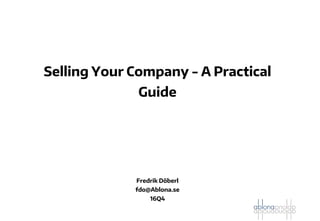Presentation innsbruck 161022 to distribute
- 1. Selling Your Company - A Practical Guide Fredrik D├Čberl fdo@Ablona.se 16Q4
- 2. CONFIDENTIAL Ablona Practical guide - Key Questions Summary Topics
- 3. CONFIDENTIAL Ablona Founded in 2004 4 persons Focus on SME ŌĆØknowledge intensiveŌĆØ
- 4. CONFIDENTIAL Selling Your Company ŌĆō mental model Typically, ŌĆØHans und GretzelŌĆØ logic ŌĆō That is, follow the path of some earlier traveler ŌĆō Low resolution & static map Instead, ŌĆØUAVŌĆØ logic ŌĆō Have an overview of your specific landscape ŌĆō High resolution & dynamic map
- 5. CONFIDENTIAL Text mining of ŌĆØread moreŌĆØ text of Amazon ŌĆØSell your companyŌĆØ books. They focus on ŌĆō Price, value, dollars ŌĆō Finding buyers in the context of the transaction ŌĆō Process The overall narrative is on ŌĆØHowŌĆØ Typical ŌĆō Popular books on ŌĆ£selling your companyŌĆØ
- 6. CONFIDENTIAL Market characterized by ŌĆØmatchingŌĆØ -> ŌĆō ŌĆØHowŌĆØ is important but not sufficient Nobel price winner 2012 ŌĆō Alvin Roth ŌĆō Popular version in the book ŌĆ£Who Gets What and WhyŌĆØ ŌĆō ŌĆ£ŌĆ”Sellers and buyers choose each other and price isnŌĆÖt the only factor..ŌĆØ ŌĆō Roths contribution on ŌĆ£algorithmsŌĆØ based on ranking (i.e. information on multivariable benefits of a potential match) Different with few, dissimilar buyers and reasons to buy
- 7. CONFIDENTIAL Who Why Ideal case: Start the mapping long before the sales starts ŌĆō THEN When, How, Where Key questions for the Practical Guide: Who & Why
- 8. CONFIDENTIAL Acquisition capabilities are unevenly distributed Who ŌĆō some observations on acquisitions in Sweden. 353 acquiring companies 581 transactions (based on Ablonas automatic data collection, see http://www.ablona.se/abl onamad ) Total population of >50 MSEK companies, ca 19 000.
- 9. CONFIDENTIAL A. High frequency acquirers. ŌĆō High probability of acquisition events, high probability of being a complementary acqusition. Low integration risk. B. Low frequency acquirers. ŌĆō Low probability of acquisition events, high probability of being a strategic acqusition. High integration risk. C. Potential consolidation area ŌĆō Very low probability of acqusition events. Analyze the business case for being the acquirer. Who ŌĆō three categories A B C
- 10. CONFIDENTIAL Understand the acquisition from the buyerŌĆÖs perspective ŌĆō Build, Borrow vs Buy decisions -> look for building ŌĆØSustainable Competitive AdvantageŌĆØ. For example, controlling a distribution channel Tool: A map (ŌĆØbusiness canvasŌĆØ) of potential buyers help to understand their context Why
- 11. CONFIDENTIAL Constructive dialogue patterns Benefits X Differentiators ŌĆō Benefits in terms of Ansoff Matrix (New, Existing offerings vs customers) ŌĆō Differentiators in terms of ŌĆØBuild, Borrow, BuyŌĆØ Why ŌĆōdialogues between buyer and seller create the opportunities
- 12. CONFIDENTIAL Some examples ŌĆō ŌĆØbetter service to customer if you buy us. Faster and less risky than building this capability yourself and a partnership would not help you withŌĆ”ŌĆØ ŌĆō ŌĆØyes, to keep your existing customers, you can can create mobile clients with our. But if you also own us, you can control the business model and the future developmentŌĆØ ŌĆō ŌĆØWe see that the industyŌĆÖs purchase behaviour is changing, they want integrated solutions. If you buy us and we combine our solution with yours. It will be much better than the competitors and together we can develop new features faster than them. Why ŌĆō Examples of dialogues
- 13. CONFIDENTIAL Who ŌĆō In your industry, who is acquiring/not acquring? ŌĆō Category A, B, C for your industry? Why ŌĆō What are the sustainable competitive advantages for these companies in A, B, C? ŌĆō Potential contribution to those? Use your marketing capability to follow these companies. ŌĆō CRM systems ŌĆō Marketing intelligence What can I do on Monday next week to prepare my company? Think ŌĆØUAVŌĆØ A B C
- 14. Increase business ownersŌĆÖ value Ablona AB, Stureplan 2, SE-114 18 Stockholm, Sweden Phone +46 (0)8 661 76 80 E-mail info@ablona.se Org.no 55 66 51 ŌĆō 15 14














